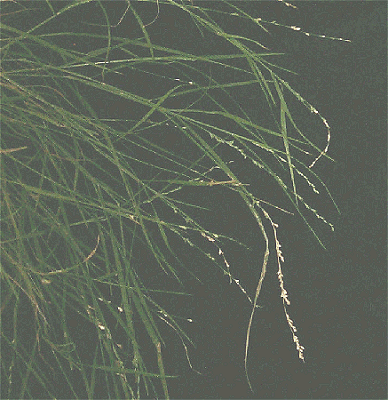 |
 |
|
 |
 |
|

Paspalidium gracile (R.Br.) Hughes
|
Common name
Slender Panic
Derivation
Paspalidium Stapf in D.Prain, Fl. Trop. Afr. 9: 15, 582 (1920);
from Paspalum (another grass genus) and the Greek -idium, a diminutive
but here employed as a name-forming suffix.
gracile- Latin for slender. Culms or inflorescences slender.
Published in
Bull. Misc. Inform. 318 (1923).
Habit
Perennial, tufted. Rootstock evident. Cataphylls present. Rhizomes short. Young
shoots extravaginal. Culms erect, 10–90 cm tall, wiry, 5–10-noded.
Mid-culm internodes solid or spongy, smooth or scaberulous, glabrous or pubescent.
Mid-culm nodes glabrous or pubescent. Lateral branches sparsely branched or
branched. Leaf-sheaths glabrous on surface or pilose, with tubercle-based hairs.
Leaf-sheaths outer margin glabrous. Ligule a fringed membrane or a fringe of
hairs, 1–1.25 mm long. Leaf-blades filiform, convolute, 7–14 cm long,
1–4 mm wide. Leaf-blade surface scabrous, glabrous or pilose, with tubercle-based
hairs. Leaf-blade margins smooth. Leaf-blade apex attenuate.
Inflorescence
Inflorescence compound, a panicle of racemes. Racemes 5–10, appressed,
unilateral, 1–3 cm long, 0.15–0.4 mm wide, bearing 5–12 fertile
spikelets on each. Central inflorescence axis 5–20 cm long, tip filiform.
Rhachis angular, 0.15 mm wide, scabrous on margins, terminating in a barren
subulate or bristle-like extension 1–2 mm long. Spikelet packing abaxial,
regular, 2-rowed.
Spikelets
Spikelets solitary. Pedicels 0.2–0.5 mm long, scabrous, tip discoid. Fertile
spikelets 2-flowered, comprising 1 fertile floret, lower floret sterile, upper
fertile, without rhachilla extension, elliptic or obovate, laterally or dorsally
compressed, plano-convex, acute, 2–3.2 mm long, falling entire. Rhachilla
internodes elongated between glumes, elongated below basal sterile floret, and
elongated between basal sterile florets.
Glumes
Glumes thinner than fertile lemma. Lower glume oblate, clasping, gibbous, 1.2–1.9
mm long, 50% of length of spikelet, membranous, 3–5-nerved. Lower glume
surface glabrous. Lower glume apex acute, muticous or mucronate. Upper glume
orbicular, 1.9–2.7 mm long, 80% of length of spikelet, membranous,
5–7-nerved. Upper glume apex obtuse.
Florets
Basal sterile floret 1, without significant palea. Lemma of lower sterile floret
similar to upper glume, elliptic or obovate, 2.1–3.1 mm long, 100%
of length of spikelet, membranous, 5-nerved, sulcate, acute. Fertile lemma elliptic
or obovate, 2–3 mm long, indurate, of similar consistency on margins, 5-nerved.
Lemma surface granulose, rugulose or rugose. Lemma margins involute. Lemma apex
acute, mucronate. Palea reflexed at apex, indurate, 2-keeled. Grain with adherent
pericarp, orbicular. Embryo 50% of length of grain. Hilum punctiform.
Continental Distribution:
Australasia.
Australian Distribution:
Western Australia, Northern Territory, South Australia, Queensland, New South
Wales, Victoria.
Western Australia: Giles, Ashburton, Eucla. Northern Territory: Barkly Tableland, Central Australia South. South Australia: Nullabor, Eastern. Queensland: Cook, Burke, North Kennedy, South Kennedy, Port Curtis, Leichhardt, Burnett, Wide Bay, Darling Downs, Moreton, Gregory North, Mitchell, Warrego, Maranoa. New South Wales: Central Coast, Northern Tablelands, Central Tablelands, Southern Tablelands, North-Western Slopes, Central-Western Slopes, North-Western Plains, South Far Western Plains. Victoria: Gippsland Plains, East Gippsland.
Classification. (GPWG
2001):
Panicoideae: Paniceae
Notes
Native. In tropical and subtropical wet sclerophyll forests, Brigalow forests,
tropical and subtropical sub-humid woodlands, temperate sub-humid woodlands,
semi-arid shrub woodlands, acacia shrublands, and arid tussock grasslands. Flowers
mostly Mar.–July.

Inflorescence (photo)
© Queensland Herbarium
Sharp 324, Simon and Latz
by D.Sharp

Inflorescence (photo)
© Queensland Herbarium
Courtesy of the Toowoomba Field Naturalist Club
by D. Sharp